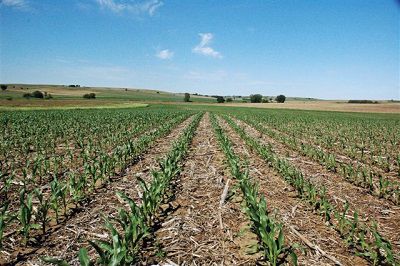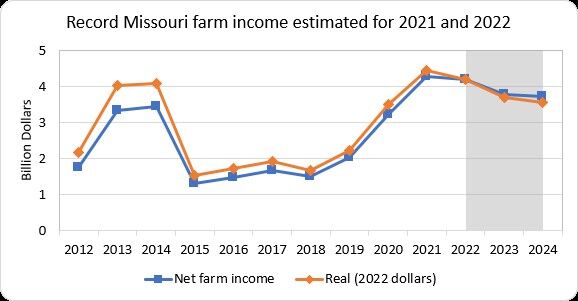ISU Land Value Survey shows 0.8 percent decrease statewide since 2017
After a reprieve in 2017, commodity prices, interest rates and trade disruptions drove Iowa farmland values down for the fourth time in five years. The average statewide value of an acre of farmland is now estimated to be $7,264. This represents a decrease of 0.8 percent, or $62 per acre, from the 2017 estimate.
Land values were determined by the 2018 Iowa State University Land Value Survey, which was conducted in November by the Center for Agricultural and Rural Development at Iowa State University and Iowa State University Extension and Outreach. Results from the survey are consistent with results by the Federal Reserve Bank of Chicago, the Realtors Land Institute and the U.S. Department of Agriculture. Wendong Zhang, assistant professor and extension economist at Iowa State University, led the annual survey.
The $7,264 per acre estimate, and 0.8 percent decrease in value, represents a statewide average of low-, medium- and high-quality farmland. The survey also reports values for each land quality type, crop reporting district (district hereafter) and all 99 counties individually.
Farmland values hit a historic peak of $8,716 per acre in 2013; however, they immediately declined by 8.9 percent, 3.9 percent and 5.9 percent, respectively, the following three years. Farmland owners received a small reprieve in 2017 when the statewide average increased 2.0 percent. While modest when compared to 2014, 2015 and 2016, 2018 marks the fourth time in five years that statewide average farmland values have declined. In nominal value, the statewide average for an acre of farmland has fallen 17 percent since 2013.
Commodity prices were one of the biggest factors driving down farmland values this year, according to Zhang.
“Lower commodity prices, in part due to the recent trade disruptions, were cited as the most significant negative factor driving down land values,” Zhang said. He also noted that despite the downturns, farmers don’t need to worry about a sudden collapse of the U.S. agricultural sector similar to the 1980s farm crisis.
“Limited land supply and strong demand by farmers still seems to hold up the land market,” Zhang said. “For five consecutive years, survey respondents have reported fewer sales than the year before, and the ag economy is still robust with 82 percent of the land in Iowa fully paid for.”
Land values by county
Seventy of Iowa’s 99 counties reported lower land values; the remaining 29 reported higher values. For the sixth year in a row, Scott and Decatur counties reported the highest and lowest farmland values, respectively. Decatur County reported a value per acre of $3,488, a gain of $8, or about 0.2 percent, from last year’s report. Scott County reported a value of $10,537, an increase of $40 per acre, or about 0.4 percent.
Hamilton County reported the largest dollar decrease in value, $285 per acre, and Humboldt and Wright counties reported the largest percentage decrease, 3.3 percent. Floyd and Mitchell counties reported the largest percent increase in values, 3.1 percent.
Land values by district
Five of nine crop reporting districts showed an increase in land values. The South Central district reported the largest percentage increase, 3.8 percent. The Central and Southeast districts reported decreases of 2.4 percent and 3.6 percent, respectively. The Northeast and Southwest districts reported no notable change in value. The Northwest and South Central districts reported the highest and lowest averages at $9,311 and $4,329 per acre, respectively.
Land value by quality
Statewide, high-, medium- and low-quality farmland values decreased 0.8 percent, 0.7 percent and 1.7 percent, respectively. Despite decreases across all other types of land in all districts, low-quality land in the Northeast, South Central and West Central districts increased in value. Low-, medium- and high-quality farmland values statewide are $4,609, $6,805 and $8,863 per acre, respectively.
“Land value equals farm income divided by interest rates. Local market competitiveness, local land availability and local income shocks tend to drive variations in land market changes across districts, counties and land quality classes,” Zhang said.
Factors influencing land values
The most common positive factors influencing land prices noted by survey respondents were limited land supply, strong yields and low interest rates. The most commonly cited negative influences were lower commodity prices, higher long-term interest rates and recent tariffs on U.S. soybeans, pork and other agricultural products.
The ISU land value survey was initiated in 1941, the first in the nation, and is sponsored annually by Iowa State University. The survey is typically conducted every November and the results are released mid-December. Only the state average and the district averages are based directly on the Iowa State survey data. The county estimates are derived using a procedure that combines the Iowa State survey results with data from the U.S. Census of Agriculture.
The ISU Land Value Survey is based on reports by agricultural professionals knowledgeable of land market conditions such as appraisers, farm managers and agricultural lenders, and actual land sales. It is intended to provide information on general land value trends, geographical land price relationships and factors influencing the Iowa land market. The 2018 survey is based on 792 usable responses from 605 agricultural professionals. Sixty-two percent of the 605 respondents answered the survey online.
CARD offers a web portal at www.card.iastate.edu/farmland that includes visualization tools, such as charts and interactive county maps, allowing users to examine land value trends over time at the county, district and state level.
Results of the 2018 ISU Land Value Survey can also be found on the ISU Extension Store.



